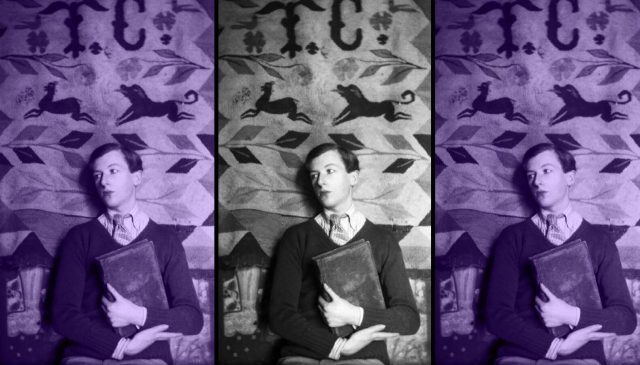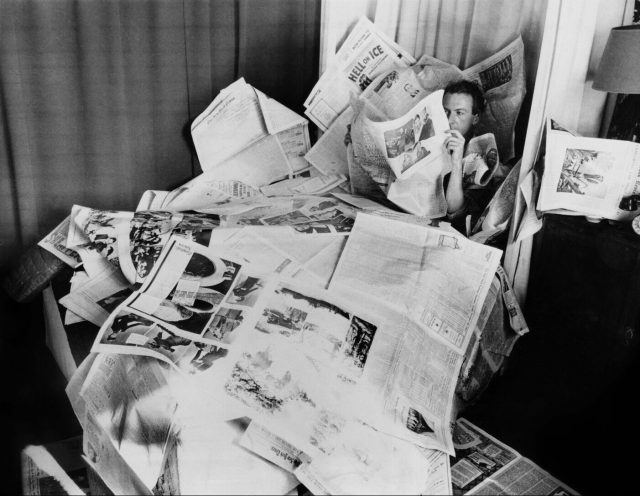
Documentary reveals Sir Cecil Beaton to be an ambitious dandy with many talents (courtesy of the Cecil Beaton Studio Archives at Sotheby’s)
LOVE, CECIL (Lisa Immordino Vreeland, 2017)
Film Society of Lincoln Center, Francesca Beale Theater
Elinor Bunin Munroe Film Center
144 West 65th St. between Broadway & Amsterdam Aves.
Opens Friday, June 29
212-875-5600
www.filmlinc.org
zeitgeistfilms.com
 Love, Cecil is a refreshing, invigorating documentary about Oscar- and Tony-winning fashion and war photographer, diarist, production designer, painter, portraitist, costume designer, illustrator, and one of the most influential dandies of the twentieth century, Sir Cecil Beaton. Writer-director Lisa Immordino Vreeland has followed up her first two feature-length films, Diana Vreeland: The Eye Has to Travel, and Peggy Guggenheim: Art Addict — she is Diana Vreeland’s granddaughter-in-law — with another behind-the-scenes journey into the art world and high society, this time explored through the lens of Beaton, who was on a neverending quest to find beauty and success in every part of his life and career. “I started out with very little talent, but I was so tormented with ambition. Once you’ve started for the end of the rainbow, you can’t very well turn back,” he wrote in one of his numerous published diaries, quotes from which are read in voiceover by Rupert Everett throughout the film. The rather self-effacing Beaton, who was born in Hampstead in 1904, was never satisfied, always wanting more. “I exposed thousands of rolls of film, wrote hundreds of thousands of words, in a futile attempt to preserve the fleeting moment,” Everett narrates.
Love, Cecil is a refreshing, invigorating documentary about Oscar- and Tony-winning fashion and war photographer, diarist, production designer, painter, portraitist, costume designer, illustrator, and one of the most influential dandies of the twentieth century, Sir Cecil Beaton. Writer-director Lisa Immordino Vreeland has followed up her first two feature-length films, Diana Vreeland: The Eye Has to Travel, and Peggy Guggenheim: Art Addict — she is Diana Vreeland’s granddaughter-in-law — with another behind-the-scenes journey into the art world and high society, this time explored through the lens of Beaton, who was on a neverending quest to find beauty and success in every part of his life and career. “I started out with very little talent, but I was so tormented with ambition. Once you’ve started for the end of the rainbow, you can’t very well turn back,” he wrote in one of his numerous published diaries, quotes from which are read in voiceover by Rupert Everett throughout the film. The rather self-effacing Beaton, who was born in Hampstead in 1904, was never satisfied, always wanting more. “I exposed thousands of rolls of film, wrote hundreds of thousands of words, in a futile attempt to preserve the fleeting moment,” Everett narrates.

Cecil Beaton catches up on some news in fab documentary, Love, Cecil (courtesy of the Cecil Beaton Studio Archives at Sotheby’s)
A member of Britain’s aristocratic Bright Young Things in the 1920s, Beaton went on to photograph such celebrities as Marilyn Monroe, Orson Welles, Marlene Dietrich, Gary Cooper, Judy Garland, Sugar Ray Robinson, Mick Jagger, and, perhaps most prominently, Queen Elizabeth and the royal family — and he wasn’t afraid to speak his mind about some of his subjects and acquaintances, saving his finest vitriol for Evelyn Waugh, Noël Coward, Katharine Hepburn, and Elizabeth Taylor and Richard Burton. He was taken with patrons Stephen Tennant and Peter Watson, artist and designer Oliver Messel, Olympic fencer Kin Hoitsma, and Greta Garbo, some of whom became his lovers. His tempestuous relationship with Garbo is one of the highlights of the film. Vreeland, cinematographer Shane Sigler, and editor Bernadine Colish maintain a slow, witty, stylish pace, matching Beaton’s general comportment. In addition to home movies, personal photographs, newspaper articles, and archival footage of Beaton on talk shows, the film includes new, revealing interviews with designer Isaac Mizrahi, actors Leslie Caron and Peter Eyre, Vogue international editor at large Hamish Bowles, auctioneer and historian Philippe Garner, model and writer Penelope Tree, Beaton’s sisters Nancy Lady Smiley and Baba Hambro, former museum director Sir Roy Strong, designer Manolo Blahnik, dance critic Alastair Macaulay, interior designer Nicky Haslam, artist David Hockney, and Beaton’s longtime butler, Ray Gurton. There’s a wonderful scene with Diana Vreeland and Truman Capote, and photographer David Bailey gives fabulous insight into his 1971 film, Beaton by Bailey, which Beaton was not very fond of. “There is scarcely a flattering self-portrait, yet truth begins with oneself,” Everett recites from a diary.
“His life was a stage,” notes biographer Hugo Vickers, while photographer Tim Walker explains, “He had a relationship with the idea of the person, not actually the person. There’s truth in fantasy.” Beaton, who redefined fashion layouts while working at Vogue and Vanity Fair, likely would feel right at home in today’s world of selfies and social media, where everyone can create and flaunt their fame. Beaton won four Tonys and three Oscars (including Best Costume Design for the original Broadway production of My Fair Lady and Best Costume Design and Best Art Direction for the movie) and is shown to be both vain and insecure, proud and melancholic, because of and despite his success. Vreeland often cuts to calming shots of Ashcombe House and Reddish House, where Beaton found peace in his garden and with his beloved cat, away from all the hubbub of high society. A splendidly dandy doc, Love, Cecil opens June 29 at the Francesca Beale Theater at Lincoln Center, with Vreeland participating in Q&As after the 7:15 show on June 29 and the 1:15 screening on June 30 (with Sigler) and introducing the 9:45 show on June 29 and the 3:30 screening on June 30.